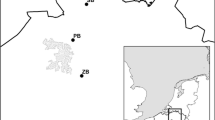Abstract
Experiments were conducted in the Mount Mary region of South Australia where the distributions of the two reptile-tick speciesAponomma hydrosauri andAmblyomma limbatum narrowly overlap. Engorged larvae and nymphs were placed in boxes with and without access to predators and left for 1 week. At two out of five sites there was greater loss from open access boxes in replicates during warmer periods of the year. Predation by ants appears to be the most likely explanation for the loss of ticks.
Similar content being viewed by others

References
Ault, S.K. and Elliott, K.D., 1979. Spider predation (Aranea:Salticidae) onOrnithodoros coriaceus (Acarina:Argasidae), with a survey of the predators of the genusOrnithodoros. J. Med. Entomol., 15: 570–571.
Bull, C.M., 1978. Heterogeneity of resource utilization in a population of the Australian reptile tick,Aponomma hydrosauri (Denny). Ecol. Entomol., 3: 171–179.
Bull, C.M. and Sharrad, R.D., 1980. Seasonal activity of the reptile tick,Aponomma hydrosauri (Denny) (Acari:Ixodidae) in experimental enclosures. J. Aust. Entomol. Soc., 19: 47–52.
Bull, C.M., Sharrad, R.D. and Petney, T.N., 1981. Parapatric boundaries between Australian reptile ticks. Proc. Ecol. Soc. Aust., 11: 95–107.
Fleetwood, S.C., Teel, P.D. and Thompson, G., 1984. Impact of imported fire ant (Hymenoptera, Formicidae) on lone star tick (Acari:Ixodidae). Mortality in open and canopied pasture habitat of east central Texas. Southwest. Entomol., 9: 158–164.
Greenslade, P.J.M., 1979. A Guide to Ants of South Australia. South Australian Museum, Adelaide, 44 pp.
Healy, J.A. and Cross, T.F., 1975. Immunoelectroosmophoresis for serological identification of predators of the sheep tickIxodes ricinus. Oikos, 26: 97–101.
Klomp, N.I. and Bull, C.M., 1987. Responses to environmental cues by unfed larvae of the Australian reptile ticksAponomma hydrosauri andAmblyomma limbatum. J. Parasitol., 73: 462–466.
Norval, R.A.I., 1976. Lizards as opportunist tick predators. Rhod. Vet. J., 7: 63.
Paine, R.T., 1971. A short-term experimental investigation of resource partitioning in a New Zealand rocky intertidal habitat. Ecology, 52: 1096–1106.
Petney, T.N. and Andrews, R.H., 1982. The influence of similar aggregation pheromones on the microhabitat choice of two parapatric species of tick (Acari:Ixodidae). Oecologia, 55: 364–368.
Petney, T.N. and Bull, C.M., 1984. Microhabitat selection by two reptile ticks at their parapatric boundary. Aust. J. Ecol., 9: 233–239.
Smyth, M., 1973. The distribution of three species of reptile ticks,Aponomma hydrosauri Denny,Amblyomma albolimbatum Neumann andAmb. limbatum Neumann. I. Distribution and hosts. Aust. J. Zool., 21: 91–101.
Wilkinson, P.R., 1970. Factors affecting the distribution and abundance of the cattle tick in Australia: observations and hypotheses. Acarologia, 12: 492–508.
Author information
Authors and Affiliations
Rights and permissions
About this article
Cite this article
Bull, C.M., Chilton, N.B. & Sharrad, R.D. Risk of predation for two reptile tick species. Exp Appl Acarol 5, 93–99 (1988). https://doi.org/10.1007/BF02053820
Accepted:
Issue Date:
DOI: https://doi.org/10.1007/BF02053820



